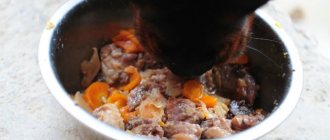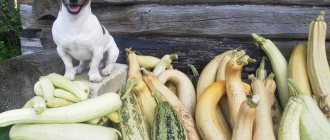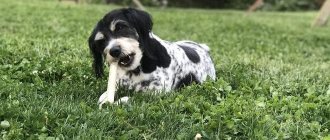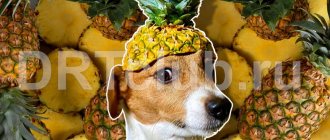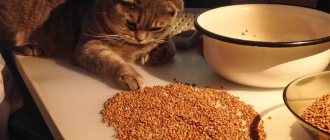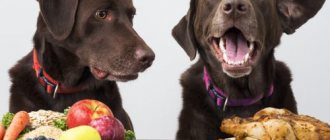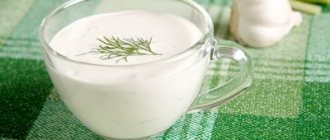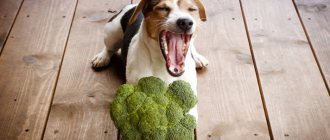Every dog owner is interested in maintaining the health of their pet for many years. And proper nutrition contributes to this.
One such product is rice . What benefits does rice porridge bring to the animal's body? What harm could there be?
According to experts, not all varieties of cereals are equally healthy, and some are even harmful in large quantities . How to choose the right variety for your pet and properly prepare a delicious dish? All you need to do is follow the recommendations below.
Benefit
For people
Rice cereal contains B vitamins, nicotinic acid, vitamin E, essential amino acids for the human body (lecithin, tryptophan, methionine), about 8% protein (per 100 g), macro- and microelements (calcium, potassium, sodium, iron, etc.).
All these substances are vital for the normal functioning of the gastrointestinal tract, nervous system, as well as for maintaining skin, hair and nails in good condition. Regular consumption of rice porridge helps remove excess salt, liquid, various toxins and carcinogens from the body.
For animals
Rice porridge for dogs is a natural source of energy and vitality, which not only saturates the body with vitamins and microelements, strengthens bones and blood vessels, but also cleanses it of toxins .
Veterinarians recommend rice (including rice water) for stomach disorders (diarrhea, vomiting), poisoning and dysbacteriosis. It is even specially included in ready-made dry food.
By regularly consuming rice porridge, your pet becomes active and cheerful. Therefore, this product is not only possible, but also advisable to add to your dog’s diet as often as possible.
What not to add to porridge
A person will find porridge tasteless if salt or sugar or butter are not added to it. But such products are dangerous for animals, so you should not feed your dog food prepared with spices. Salt, even in limited quantities, will not harm only animals with 100% health of the heart, liver, kidneys, stomach, bones and joints. And sugar is completely prohibited for pets. Sweets affect the animal's weight, and there is a high risk of developing diabetes.
Other seasonings have a detrimental effect on the walls of the stomach. Pepper irritates the esophagus, stomach and intestinal mucous membranes. Nutmeg negatively affects the nervous system. A dog can even be poisoned by onions and garlic; regular consumption of them threatens the pet with anemia.
Butter and margarine are not recommended for dogs. A high percentage of fats contained in foods harms the cardiovascular system, digestive organs, and has a detrimental effect on the liver. Fats for overweight dogs are strictly prohibited.
Can it cause harm?
Dog breeders should keep in mind that white polished rice is not only unhealthy (since after processing it loses most of the nutrients), but also has an extremely negative effect on intestinal function (due to the high starch content), causing constipation and being one of the causes of obesity.
The thing is that in the stomach starch is converted into sugar and gradually causes the deposition of fats in the body.
If your dog experiences constipation, then dishes with rice (white polished) should generally be reduced to a minimum. Important! White polished rice is especially harmful to dogs leading a sedentary lifestyle (sitting on a chain). Since the increased content of starch in the product (especially with frequent feeding) provokes obesity and disrupts the functioning of internal organs . And in the absence of physical activity, this is a double blow to the pet’s health.
Allergy
If we talk about allergies to the product, then in rare cases this is possible .
The main signs of an allergic reaction include:
- gastrointestinal disorders (diarrhea, vomiting);
- sneezing and watery eyes;
- itching and rashes on the skin.
In order to find out whether a product is a source of allergy, it is worth passing a sensitivity test by taking a blood test to the veterinarian. clinic. Or simply observe the reaction of the animal’s body after eating rice.
Is it possible to use pasta in a dog's diet?
Owners always strive to make their pet’s food varied and tasty. But they approach the concept of taste from their own point of view. Therefore, they often offer their pet a plate of pasta seasoned with a delicious sauce.
Of course, the dog will eat the whole plate at once and will be very satisfied. But will such a treat be beneficial?
Photo: netdna-ssl.com
What is pasta made of? Strictly speaking, it's water and flour. Some types have added egg and butter. It seems that all components pose absolutely no danger. Well, except that wheat can cause allergies.
On the other hand, it turns out that boiled pasta does not provide any benefits, since it does not contain any nutrients. And they are needed only to quickly fill the dog’s stomach and deceive hunger.
If your dog ate pasta, what should you expect? It all depends on the individual characteristics of the body. Some animals eat pasta all their lives, even without the addition of meat and vegetables, and do not feel discomfort. Others experience fermentation, gas formation and diarrhea.
Note that those dogs that eat pasta will, in any case, have health problems. Frequently eating high carbohydrate foods will:
- obesity;
- pancreatitis;
- diabetes mellitus
Many dogs love to play with dry foods and eat them in the process. It is better to protect your pet from such games. Dry pasta, as well as dry instant noodles, can stick to the roof of your mouth, teeth, and throat. The dog will experience agony and suffocate. Once in the stomach, dry products will swell and turn into a sticky lump that is difficult to digest.
There is nothing to say about pasta seasoned with spices and rich sauces. This kind of food should not be given to a dog!
If you still decide to feed the animal with this product, then you should choose products made from durum wheat.
Constantly feeding pasta will only cause harm. However, in some cases, it is acceptable to offer them to your pet. It was said above that they contain practically no useful substances. But there is still a minimal share: B9 and B12, tocopherol, B2 and B3.
Tocopherol has a positive effect on the reproductive system, B vitamins are needed by pregnant dogs and for the normal functioning of the gonads.
Each owner himself decides what to feed his pet, taking into account financial and other possibilities. But cereals are not much more expensive, but they provide much more benefits.
Photo: pixabay.com
For puppies
Rice porridge can be introduced into a dog’s diet starting from 1-2 months of age , but in case of constipation and deterioration of the pet’s condition, the product must be replaced with another type of cereal (oatmeal, buckwheat).
For puppies, it is best to cook rice with either water (without spices) or milk. The main condition: the porridge should be semi-liquid.
Do you need vitamins?
Many dogs are selective about vegetables, greens and fruits. Such “gourmets” are recommended to add daily supplements to their basic diet, for example:
- Nutri-Vet Multi-Vite;
- 8 in 1 Excel Multi Vitamin.
If the dog’s diet is sufficiently varied and balanced, vitamins are given in courses of 4-8 weeks once a quarter or as needed (periods of increased stress for sporting and hunting dogs, cold seasons, seasonal shedding), for example:
- Beaphar Laveta Super;
- Canina Enzym – Hefe;
- Phytoelite.
Vitamins are selected taking into account the size of the dog. Feeding a St. Bernard complex to a Yorkie will not be beneficial. An excess of vitamins is just as dangerous as a deficiency.
There is no need to change the diet if it meets all the dog’s needs. The body adjusts and adapts to the digestion of certain foods over a long period of time. Sudden changes (even switching from one grain to another) can cause digestive upset.
In what quantities and how often should I give?
Rice porridge should not be given daily. Optimal rate: 2-3 times a week. Experts recommend alternating it with other cereals (buckwheat, millet, oatmeal) or cooking combined porridge (from several cereals at once).
As for the number of servings, it all depends solely on the size and weight of the dog. So, when feeding small breeds (toy terrier, Pekingese, pug, etc.), you should limit yourself to 100-150 g portions. For large dogs (German Shepherd, Labrador, etc.), the serving size can be increased by 2-3 times.
Attention! Dogs that are overweight or prone to obesity should be given the product as rarely as possible (this only applies to white polished cereal).
What cereals can be given to dogs of small and large breeds
For some reason, people very often believe that the choice of cereals is different for large and small breeds. This is wrong. Buckwheat and oats (rolled oats) are best suited for the diet of both large and small dogs. But it is better to avoid corn, semolina and some other cereals. We have already written about all this in the relevant sections of the article.
From the author. We feed our Irish Setter exclusively natural food. For breakfast we give cottage cheese and kefir. And for dinner, porridge and meat, usually rolled oats, less often buckwheat.
How to choose?
When choosing cereals, you should adhere to the following recommendations:
- The preferred variety is brown rice (or brown) , because... with gentle processing, it retains most of the nutrients and contains less starch. The cost of brown rice (parboiled) is slightly higher than white rice. It can be found in regular supermarkets, next to the polished one.
- Rice must be fresh, without a musty smell.
- The grains should not be cracked or crumbly.
- White rice should have a transparent texture. Otherwise, it was harvested unripe.
- The grade must be “superior”, “first” or “extra”. Grades 2 and 3 are not suitable for dogs.
Is it possible to feed brown (brown)?
This variety not only can, but also should be used to feed your pet. It contains a lot of fiber and other useful substances (vitamins and microelements).
The advantages of this variety are as follows:
- it does not boil over and has a pleasant taste;
- contains less starch and many times more nutrients;
- does not cause constipation and obesity.
Features of dog digestion
Based on the type of digestive system, dogs are classified as omnivores. Over 10,000 years of living next to humans, she learned to digest sugar, fiber and starch. This fact is confirmed by genetic studies.
Peculiarities of digestion depend on the climate, geography and culture of the people in whose surroundings the breed was formed, and other factors. For example, many European Shepherds have survived for centuries on a meager, low-protein diet. In Serbia, herding dogs were fed mainly with cornmeal and semolina porridge, a small amount of meat, offal, and vegetables. Not a single native Japanese breed can live happily on such a diet; its digestive system is tuned to meat, fish, rice, and vegetables.
Not all cereals are equally healthy
It is impossible to definitively answer the question of which porridge is best for dogs. There are general recommendations regarding feeding, but first of all you need to take into account the individual digestive characteristics and taste preferences of your pet. The digestibility of porridge can be judged by the amount of undigested cereal in the feces. If there is a lot of it, it is better to discard the product. Also, cereals should be immediately removed from the diet if they cause digestive upset.
How to cook for a pet?
When cooking rice cereal, the following rules must be observed :
- Before cooking, the cereal should be washed in running water.
- If your pet is picky about food, you can lightly salt the water.
- The porridge is cooked for 20-30 minutes under a tightly covered lid.
- If the cereal is ground, then before the water boils, add 1 teaspoon of oil (sunflower, olive) to the pan. This way the porridge will be more crumbly.
Advice! Depending on the degree of processing of the cereal, the cooking time may vary slightly . So, unpolished grains are boiled 10-15 minutes longer and then infused for 30 minutes.
As mentioned above, rice can be combined with other cereals (buckwheat, oatmeal, wheat, etc.). This can be done either in combination with one grain or with several at once.
Porridge can be cooked with milk or broth, adding cottage cheese, kefir, vegetables, meat, fish, eggs, vegetable or butter.
Recipe for rice porridge with chicken and carrots
Ingredients: chicken meat (or chicken), rice, carrots.
Preparation:
- Cut the chicken, add water and cook until done.
- At the same time, boil rice porridge in another pan.
- Remove the finished chicken from the broth, cool and cut into small pieces (you can grind it into minced meat).
- Peel the carrots and grate on a coarse grater.
- Combine all ingredients, mix and add a spoonful of vegetable oil.
How to cook porridge for a dog
A lot depends on how the lunch is prepared: preservation of benefits, digestibility for the animal, taste characteristics. For example, any cereal, when cooled, becomes useless, so it is better to throw away the leftovers.
Broths prepared with meat can be stored for up to 2 days and no more. Later they lose their beneficial properties and there is a risk of poisoning.
Cooking porridge for dogs has several rules that every owner should know:
- By soaking buckwheat and rice before cooking, they improve the properties of the cereals and pour cold water for 20 minutes.
- Sticky porridges are cooked with a little oil, then they turn out crumbly and tasty.
- Oatmeal goes well in addition to other cereals.
- Animals should not cook milk porridges; they are poorly digestible. It is best to cook food in broth or plain water.
- The pan in which food is stored must be tightly closed to prevent the entry of foreign objects.
It is impossible to keep food in the refrigerator for a long time; it is optimal to cook it for one meal, for small dogs it can be done for a day.
What should I do if I ate it raw?
If your pet accidentally eats a small amount of raw rice, there is no need to worry . The grains will leave the body naturally. The only thing you should be wary of is constipation. If your dog becomes constipated after eating raw cereal, you should give the animal a mild laxative:
- Bimin - at the rate of 1 ml per 1 kg of weight.
- Vaseline oil (1 teaspoon per 1 kg of weight). The oil can be given either in its pure form or mixed with food.
If your dog experiences other inappropriate reactions after eating rice cereal (abdominal pain, nausea, weakness, refusal to eat, diarrhea), you should contact your veterinarian .
Depending on the breed
German Shepherd
Porridge should make up 25-35% of the total diet. You can give buckwheat, rice and oatmeal porridge. They are usually supplemented with meat and vegetables.
Mom-Dad, thank you for the delicious porridge!
Husky
Steam oatmeal flakes with boiling water and let steep for 10 minutes. It is not recommended to give oatmeal often, because... it weakens, but can easily be replaced with rice or buckwheat. Add raw yolk, a little raw minced meat and cottage cheese - voila, breakfast is ready!
Malamute and Husky: 12 differences with clear photos
Labrador
The following recipe is useful for Labrador puppies: steam finely ground oatmeal with milk, add 1 tsp. fish oil and 2 glucose tablets. You can also cook buckwheat with meat in vegetable broth.
“Can I have some more porridge?”
Devoted friends Golden Retriever and Labrador: 5 differences
York
For Yorkies (as well as Shitzus, toy terriers and pugs), oatmeal and semolina are unacceptable, because... These dogs are prone to obesity. To prepare a delicious porridge for your Yorkie, take a small carrot, a little cauliflower, and 2 tablespoons of buckwheat. Cook everything until tender (about 30 minutes), then mix the resulting dish with a blender, add a little unrefined vegetable oil, boiled beef or chicken and serve the porridge to the dog. There should be no salt and pepper!
Calculate a serving of cooked porridge as follows: 500 grams. pet's weight - 1 tablespoon of porridge.
Other cereals
In addition to rice, dogs can also be given other grains. These include:
1. Buckwheat - contains magnesium, iron, potassium, calcium, proteins, vitamins B and E. Porridge helps strengthen the skeletal system, has a beneficial effect on the nervous and circulatory systems, and eliminates excess weight.
Advantages over rice: it is better absorbed by the body, does not cause constipation and other gastrointestinal disorders. The advantages are especially obvious over polished rice.
Disadvantages: none.
2. Oatmeal (or rolled oats) - contains a large amount of protein, fats and amino acids. Porridge saturates the body with useful substances, increases mental and physical activity.
Advantages: well absorbed, does not cause constipation and obesity.
Disadvantages: possible allergic reactions, gastrointestinal disorders, not suitable for all dogs.
3. Semolina is less healthy than other cereals. Contains essential microelements (iron, potassium), a small amount of fiber, and B vitamins.
Benefits: recommended for stomach diseases, easily digestible during puppyhood, normalizes the functioning of the heart and nervous system.
Disadvantages: in large quantities it can cause allergies.
On our website there are also articles about the benefits and harms of porridges for dogs: millet, corn and others.
Is it possible
Both puppies and adult dogs are strictly advised not to eat certain grains, as they can cause indigestion, metabolic disorders, allergic reactions and other serious health problems.
Dairy
Compatibility test: can a dog have milk and fermented milk products? Artificial feeding of a puppy: substitute
Hercules
Let's turn to oatmeal. Oatmeal is high in calories, it has more fiber, protein, fat, calcium and phosphorus than rice and buckwheat. However, it is worth noting that it is only suitable for active dogs: castrated and sterilized animals are not allowed to give oatmeal . But for those who actively run and jump, it is possible.
In some dogs, oatmeal causes intestinal upset - this is individual and, of course, it is better to exclude it from the diet. But for dogs suffering from gastritis and stomach ulcers, oatmeal broth or jelly is very useful. Weakened, sick animals, pets on a diet, and growing puppies will only benefit from oatmeal.
“I’ll cook everything for myself”
Can a dog eat oatmeal? It is possible if this dog eats oatmeal all its life, does not get fat from it, and its intestines cope.
Is it necessary to specifically switch the dog to oatmeal porridge? No.
In any case, oatmeal, like any other cereal, requires correction and can be given within certain limits, without replacing meat with it.
Manna
Many people are interested in the question: is it possible to feed semolina porridge to babies? In fact, semolina is used mainly for those puppies (from newborns to a maximum of 3 months) who need to gain weight.
It is very high in calories, but it contains almost no vitamins and microelements (only a little potassium and iron), a small dose of fiber (only 0.2%), but a large amount of B vitamins.
Semolina is also allowed on the recommendation of a veterinarian in the treatment of gastrointestinal diseases. It is sometimes allowed to give it to older puppies, but in moderation.
Millet
Millet is too difficult to digest and can even cause intestinal volvulus. In addition, millet can cause severe allergies! Even mixing with other cereals is undesirable.
Pearl barley
Pearl barley , which is an allergen, is also contraindicated And despite the fact that barley contains a lot of vitamins, the body of a dog, especially a puppy, cannot even absorb a third of them. In addition, eating pearl barley porridge leads to constipation and even allergies in dogs.
Legumes are undesirable - they often cause bloating. It is strictly forbidden to give porridge made from corn grits , it is also practically not digestible in a dog’s stomach. Corn may be fresh or cooked on the cob.
Wheat and barley porridge can only be consumed by adult and healthy dogs leading an active lifestyle..
Foods that are not recommended for dogs
Do not give your dog legumes, potatoes, or pearl barley.
Foods that are not recommended to give to your dog:
- Fish and tubular bones
- since fish bones are very sharp, and tubular bones break into sharp fragments, your pet can seriously injure the esophagus and intestines - Salty dishes
- it is not advisable to give moderately salty foods. You need to add a little salt. Since dogs do not have sweat glands, and salt, as is known, retains fluid in the body, edema appears. Which have a depressing effect on the animal - Spicy, smoked, sausages, cheeses, spicy, pickled
- cause swelling and gastrointestinal disorders - Fat and fatty meat
- obesity develops - Onions, garlic, grapes
- these foods are considered poisons for dogs - Legumes
are not digested at all and are not absorbed by fatty acids - Barley
is not digestible - Millet
- with caution, it causes allergies in some dogs - Corn
is poorly digested and takes a long time to digest. - Semolina
- recommended only for puppies - meat
- no harm, but no benefit. Doesn't have time to digest - Cabbage
- in large quantities, bloating due to the large formation of gases. The dog feels discomfort - Potatoes
have a bad effect on J.K.T.
Possible additives
Milk
Dairy products are the most important nutritional element for puppies, especially under three and a half months of age. You can cook cereals in milk, or you can cook them in water, low-fat meat or vegetable broth.
Milk, kefir, yogurt, cottage cheese or yogurt should be added to ready-made porridge with water or milk or fed separately. Also add pieces of vegetables and fruits, berries, nuts to the porridge, and add a teaspoon of honey.
Meat
It is possible and healthy to feed your puppy veal, beef, veal, lean lamb, rabbit and turkey meat, horse meat , cook and mix meat by-products such as heart, kidneys, lungs, and liver with porridge and vegetables.
Chicken should be added to the diet carefully and carefully monitor how your pet’s stomach reacts to it.
The meat must be frozen for two or three days and defrosted to room temperature before feeding.
Instead, you can also pour boiling water over it, put it in the porridge a few minutes before it’s ready and boil it a little, leaving it half-baked. For broth, it is best to use bones rather than meat, which are then removed. Meat by-products can be processed in the same way as meat, but it is preferable to boil them.
IMPORTANT ! Poultry meat must be separated from the bones and added to the porridge; giving bones is strictly prohibited.
Fish
Sea fish can be fed raw or in the same way as meat, but river fish must be processed to eliminate the risk of infection with parasites. First, you must remove all the bones from the fish or boil and grind it along with them.
Vegetables
Vegetables in porridge are placed finely chopped, raw, boiled, steamed, sometimes lightly fried, either one type or several at once. These can be beets, white and cauliflower cabbage, broccoli, bell peppers, cucumbers, zucchini, carrots, as well as greens in moderate quantities: lettuce, dill, sorrel, parsley, beet tops, cereal sprouts, etc.
IMPORTANT ! Vegetables and fruits should be washed, vegetables should be peeled. Nettle must first be doused with boiling water.
Fats
1-2 times a week you should add a hard-boiled chicken egg or a raw yolk without white.
Starting with a few drops and gradually increasing to a teaspoon, you can add vegetable oil, and from two months of age - fish oil. Also add crushed chalk or eggshells to the porridge (it should be crushed especially carefully to prevent the ingress of sharp particles), and a little butter.
IMPORTANT ! It is forbidden to give puppies fatty meat, pork, minced meat, and smoked meats. You should also not add sugar or sweets, since dogs cannot digest glucose and can cause fermentation in the intestines. Hot foods and spices can irritate the stomach, and sausages contain many harmful substances.
Pasta is allowed, infrequently and in moderation.
You should teach your puppy to eat a variety of foods. If the puppy has a predilection for something specific, this should be taken into account, and for the rejected food, take a break for a week or two. Sometimes you can add salt, but not a lot and not often: salt itself is found in all foods.
Each new product should be introduced into the diet gradually and monitor the intestinal reaction and possible allergic skin reaction. If necessary, a break is taken.
IMPORTANT! Dry food should not be mixed with porridge or other natural products.
How harmful are porridges?
Dogs are carnivorous animals. In the wild, their ancestors ate primarily meat. Therefore, cereals are not a natural food for this species.
Excess cereals in the diet negatively affects the acidity of the stomach. This organ begins to produce digestive juices in insufficient quantities. As a result, it becomes difficult for the pet to digest natural food - meat and bones.
In addition, excessive consumption of cereals promotes the proliferation of putrefactive bacteria in the intestines. At the same time, toxic substances penetrate into the blood, causing allergic reactions.
Content
1. Can a dog have rice? – We consider the positive aspects 2. What risks are present 3. How to choose? 4. Cooking process
Any owner of a four-legged barking friend wishes him nothing but good and health. And to achieve this goal, you need to properly work out your diet. People often wonder whether a dog can eat rice, buckwheat and other grains. It is certainly and definitely possible, and even necessary, especially in cases where natural food similar to human food is used. But it is very important to correctly determine the type of rice, as well as the serving sizes.
